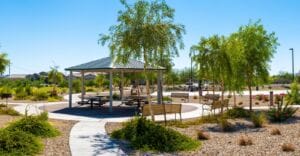Phoenix is ground zero for a new multifamily housing product gaining popularity across the nation: single family build-to-rent (BTR) communities. Sometimes referred to as low density multifamily or horizontal apartments, these BTR developments offer another option for renters who don’t want to live in multistory apartment buildings but can’t or won’t commit to a home purchase.
Would-be homeowners in Metro Phoenix have seen listings vanish nearly as soon as they appear online, sent in offer after offer only to be outbid by a cash buyer all while prices soared — home values are up 22% year-over-year, according to Zillow’s Home Value Index data.
To be sure, indicators such as increased inventory levels are showing a cooling of the housing market. Rising mortgage rates also discourage buyers from making a purchase — since much more of their monthly payment would go to interest — and instead they are pursuing other options, such as renting or simply staying put.
Brandon Harrington, managing director at NorthMarq, says that elevated home prices and the current interest rate environment make it difficult to qualify and afford a home mortgage, which is driving demand for multifamily options like BTR communities.
“I’m super bullish on multifamily, BTR and all forms of housing, because we do have a lack of supply,” Harrington explains. “We have major population growth, and we have huge job growth. A lot of those jobs aren’t even here yet, so I think we’re going to continue to see huge demand for housing going forward.”
Build-to-rent
Considering there isn’t consensus around the name of this product, it’s unsurprising that there are variations in how developers are approaching BTR. Jacque Petroulakis, executive vice president of marketing and investor relations at NexMetro, says that their communities are self-enclosed and are built to be leased in perpetuity.
“There are others out there that build scattered homes for rent that could easily be sold. That’s not our platform,” she says. “There are lots of ways to execute this offering, and ours is a professionally maintained, for lease, detached wall community, though we do have some duplexes.”
NexMetro has a significant presence in Metro Phoenix, with 23 communities either completed or under construction. Under the brand Avilla Homes, the developer offers one, two and three-bedroom floor plans along with a communal pool and pet-friendly recreation areas.
Another player in this burgeoning segment is Curve Development. Nate Pile, president and owner of Curve Development, notes that the overwhelming majority of BTR communities in Phoenix are in the horizontal apartment mold, which he defines as one, two and three-bedroom bungalow-style units without garages.
“Our model is centered around creating a community where you can’t tell whether it’s a rental or for sale home,” Pile continues. “[Our units] are actual single-family homes with two car garages and true backyards. Our goal is that if you rent it in our community, and your family came to visit, they’d have to ask you if you’re renting or not.”
READ ALSO: Here’s how build-to-rent housing is impacting Arizona real estate
Further evidence of the strength of BTR is the entrance of one of the nation’s largest homebuilders — Taylor Morrison. Darin Rowe, national build-to-rent president for Taylor Morrison, says that it made sense for the company to do what they do best: find land, develop the dirt, build houses and serve customers.
“There are a lot of niches that builders and apartment developers alike have subscribed to and ours is truly complementary to our core business,” Rowe says. “We develop multifamily communities that look like apartment complexes but live more like single-family home communities.”
As such, Rowe adds that based on their product type and strategy, Taylor Morrison’s BTR communities are competing directly with apartments. Rather than building upward of four stories of apartments, he explains, Taylor Morrison takes a “low density multifamily” approach of 10 units per acre.
“[These units] come with the lifestyle functionality of a dedicated backyard and a doggie door,” Rowe continues. “If you’ve lived in an apartment complex, and you were upstairs and had to walk your dog in your pajamas on a leash every morning to find a patch of grass, or if you had to carry groceries up flights of stairs or had noisy neighbors above and below — [BTR communities] solve those issues.”
Renters by choice
Not only are the BTR communities being built differently depending on the developer, but they are attracting a different type of tenant, and not just pet owners. Petroulakis says NexMetro’s target demographic includes millennial professionals not ready for homeownership and people in life transition — such as a recent divorcee who had been in a single-family home and wants to avoid living in an apartment building but doesn’t want to purchase another house yet. She also mentions that empty nesters looking to downsize are attracted to maintenance-free living without worry of an unexpected costly repair, especially Baby Boomers on fixed incomes.
“It’s a very diverse group of consumers, all leasing in the same neighborhoods for different reasons, but the most compelling reason is they want the lifestyle of a home. They don’t want the typical multifamily offering that’s been in the market,” Petroulakis explains.
Many of the people in these communities, Petroulakis says, are considered renters by choice, meaning they have the financial wherewithal to afford a home purchase, but for whatever reason elect not to.
For Curve Development, the way their communities are built means some people are choosing to rent before making a nearby home purchase. One of the company’s developments in Orlando, Florida is part of a larger master-planned community with approximately 3,000 homes.
“We have seen interest from people who might want to buy and maybe it’s not the right time because of the pricing or they just moved,” Pile says. “We find ourselves to be a benefit to the master plan and the for-sale builders because a renter could love the area and end up buying a home three or four parcels over.”
A similar calculus is at work for Taylor Morrison, according to Rowe. “We can build [BTR and traditional single-family homes] in the same or adjacent parts of town and cater to those interested in purchasing a home, or if the time is not right and they would prefer to rent, and have an option for them as well,” he concludes. “That’s why it made sense to lean into this space.”



